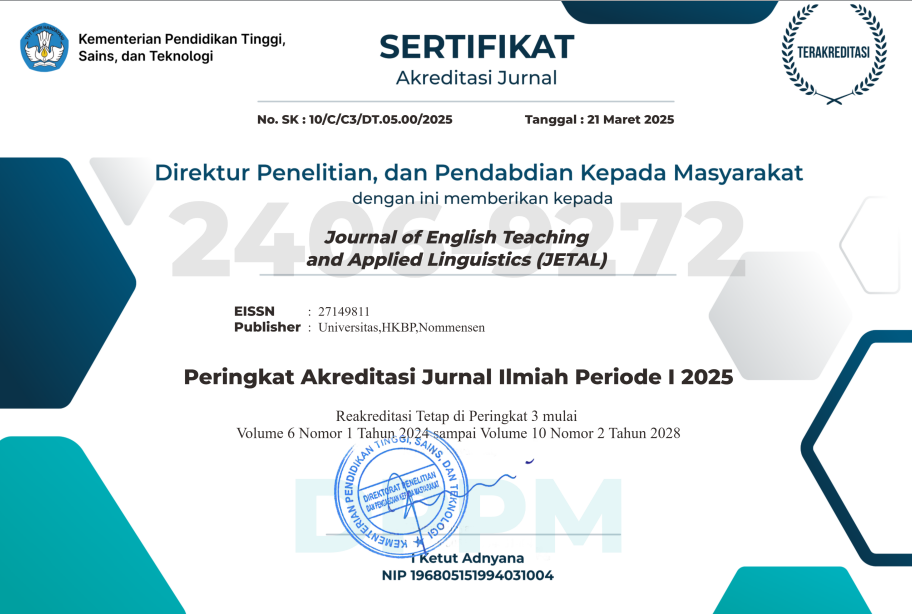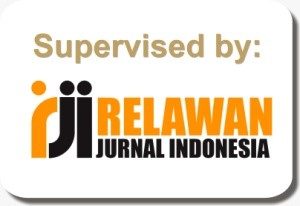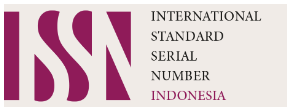Linguistics Realization Analysis on Slang Word; Social Media Whatsapp
Abstract
Nowadays supporting in communication ways in easier by Electronics many applications using to communication as Facebook, WhatsApp, Instagram, Line and others. The development of era has been influence in communication and interaction way. Many of slang word used in communication in verbal, orally or written. Slang is one of effect of social life in language it is part of language variety which are informal which used to communication as members in social community. With slang people used, is one indicating people are modern and impressive. Objectives of this Research is gives points about Sociolinguistics Slang Word; using on Social Media especially in WhatApp Application. From these article wish we found what kinds of Slang word used on WhatsApp Media. Method used in this research is qualitative method to analyze data. Data obtained came from WhatsApp Application that used teenagers in Author WhatsApp Group. For collecting the data, Author used the method of observation. Author found some slang words that using teenagers in popular slang as : “Jelly” meaning Jealous, “Swag” means Cool, “Y” means why, “Zzz” Means Sleeping, “Imo” means In my opinion and others.
References
Lambert, V. A., & Lambert, C. E. (2013). Qualitative Descriptive Research: An Acceptable Design. Pacific Rim International Journal of Nursing Research, 16(4 SE-Editorial), 255–256. https://he02.tci-thaijo.org/index.php/PRIJNR/article/view/5805
Lutviana, R., & Mafulah, S. (2021). The use of slang words in online learning context of EFL class. EnJourMe (English Journal of Merdeka) : Culture, Language, and Teaching of English, 6(1), 55–62. https://doi.org/10.26905/enjourme.v6i1.6118
Nasution, J. S., Rahmadeny, M., & Jazzawi, I. (2019). The Importance of Sociolinguistics in Foreign Language Education: A Review of Selected Paper. International Journal for Educational and Vocational Studies, 1(4), 299–303. https://doi.org/10.29103/ijevs.v1i4.1415
Novitasari, N. F., & Hia, N. I. A. (2021). CYBERBULLYING IN MOVIE CYBERBULLY: AN ANALYSIS FROM THE PSYCHOLOGICAL PERSPECTIVE . Celtic : A Journal of Culture, English Language Teaching, Literature and Linguistics, 8(1 SE-Articles), 44–64. https://doi.org/10.22219/celtic.v8i1.16393
Nuraeni, F. W., & Pahamzah, J. (2021). an Analysis of Slang Language Used in the Teenager Interaction. Litera, 20(2), 313–322. https://doi.org/10.21831/ltr.v20i2.37058
Putri Nur Hidayah. (2021). THE USE OF UN/MARKED CODE TO SHOW POLITENESS AMONG MULTILINGUAL CUSTOMERS. Celtic : A Journal of Culture, English Language Teaching, Literature and Linguistics, 8(2 SE-Articles), 177–189. https://doi.org/10.22219/celtic.v8i2.16692
Rezeki, T. I., & Sagala, R. W. (2019). Slang Words Used By Millennial Generation in Instagram. Jurnal Serunai Bahasa Inggris, 11(2), 74–81. https://doi.org/10.37755/jsbi.v11i2.162
Silalahi, E. B. (2020). Applying Round-Robin Brainstorming on Introduction to Linguistics class. EnJourMe (English Journal of Merdeka) : Culture, Language, and Teaching of English, 5(2), 149–157. https://doi.org/10.26905/enjourme.v5i2.4048
Swarniti, N. W. (2021). The Analysis of Semantics Meaning Found In Comments of Instagram Account of Info Denpasar. Prosiding Seminar Nasional Linguistik Dan Sastra (SEMNALISA), 193–199.
THE MORPHOLOGICAL PROCESS.pdf. (n.d.).
Trimastuti, W., Piksi, P., & Bandung, G. (2017). AN ANALYSIS OF SLANG WORDS USED IN SOCIAL MEDIA. In Jurnal Dimensi Pendidikan dan Pembelajaran (Vol. 5, Issue 2).
Usman, A., Mahmud, A., Daud, A., & Dahlan, S. (2022). LANGUAGE AS A SOCIAL INSTRUMENT. Edukasi, 18, 259–276. https://doi.org/10.33387/Edu
Authors retain copyright and grant the journal right of first publication with the work simultaneously licensed under a Creative Commons Attribution-ShareAlike 4.0 International License (CC BY-SA 4.0) that allows others to share the work with an acknowledgment of the work's authorship and initial publication in this journal.
Authors are able to enter into separate, additional contractual arrangements for the non-exclusive distribution of the journal's published version of the work (e.g., post it to an institutional repository or publish it in a book), with an acknowledgment of its initial publication in this journal.
Authors are permitted and encouraged to post their work online (e.g., in institutional repositories or on their website) prior to and during the submission process, as it can lead to productive exchanges, as well as earlier and greater citation of published work (See The Effect of Open Access).






